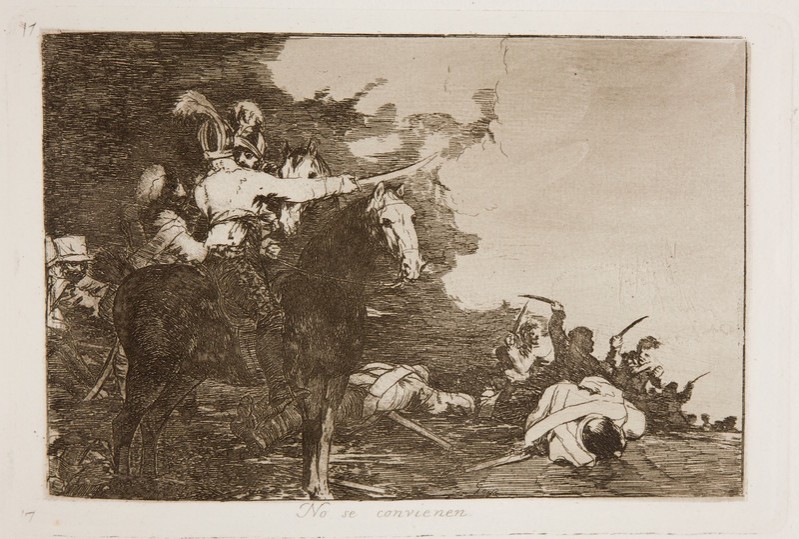- Cronología
- Ca. 1810 - 1812
- Dimensiones
- 143x213 mm
- Técnica y soporte
- Etching, burin, drypoint and burnisher
- Reconocimiento de la autoría de Goya
- Undisputed work
- Ficha: realización/revisión
- 30 Nov 2010 / 02 Jun 2023
- Inventario
- 225
Goya (bottom centre and to the left), 17 (lower left-hand corner).
See Sad presentiments of what must come to pass.
In the second state proof for this print burin was used to retouch those patches where the etching had not bitten successfully.
The title was handwritten by Goya on the first and only print run that we know to have been made at the time, and which the painter gave to his friend Agustín Ceán Bermúdez. The title was engraved on to the copperplate at a later date, and no other modifications were made to the image for the first edition of the Disasters of War, which was printed by the Royal Academy of Fine Arts of San Fernando, Madrid, in 1863.
When the first print run was made, this image was included after no. 76, The carnivorous vulture, after the number was read incorrectly. Similarly, etching no. 77, The rope is breaking, was mistaken for number 17. For this reason, that number has been engraved both in the upper right- and left-hand corners.
No preparatory drawings for this print have been conserved.
Two officers (it is not clear whether they are Spanish or French) on horseback, positioned on the left-hand side of the print, are discussing the subsequent movements of their troops. They appear to be in disagreement about what tactics to use next. At the same time, on the right-hand side of the image, a bloody battle is underway. Nothing disturbs the argument between the two officers, not even the corpses lying beside them or the suffering and sacrifice of those in the middle of the fight.
The scene is divided diagonally into two parts. The left-hand side, where the commanding officers are, is dark and has been executed using short, very tightly packed horizontal lines. The horse in the foreground, the calmest figure in the whole scene, looks out, apparently perplexed, at the viewer. Its body has been rendered in energetic, criss-crossing diagonal strokes. On the right-hand side of the composition, set apart by the diagonal line, we see the white surface of the paper and, standing out against this pale background, the silhouettes of the men engaged in battle.
This etching is an obvious critique of the way in which people are manipulated in every military conflict, in which they become a mere weapon to be wielded by those in power. This idea holds as much for the French as it does for the Spanish, which is possibly why Goya has chosen not to identify the arguing figures.
La plancha se halla en la Calcografía Nacional (cat. 268)
-
De grafiek van GoyaRijksmuseum RijksprentenkabinetAmsterdam1970from November 13th 1970 to January 17th 1971cat. 65
-
Francisco de GoyaMuseo d'Arte ModernaLugano1996exhibition celebrated from September 22nd to November 17th.cat. 17
-
Francisco Goya. Sein leben im spiegel der graphik. Fuendetodos 1746-1828 Bordeaux. 1746-1996Galerie KornfeldBern1996from November 21st 1996 to January 1997cat. 105
-
Ydioma universal: Goya en la Biblioteca NacionalBiblioteca NacionalMadrid1996from September 19th to December 15th 1996cat. 210
-
Goya. Opera graficaPinacoteca del Castello di San GiorgioLegnano2006exhibition celebrated from December 16th 2006 to April 1st 2007p. 59
-
Goya et la modernitéPinacothèque de ParisParís2013from October 11st 2013 to March 16th 2014cat. 56
-
Goya: Order and disorderMuseum of Fine ArtsBoston2014cat. 195
-
Goya, grabadorMadridBlass S.A.1918cat. 119
-
Goya engravings and lithographs, vol. I y II.OxfordBruno Cassirer1964cat. 137
-
Vie et ouvre de Francisco de GoyaParísOffice du livre1970cat. 1019
-
Catálogo de las estampas de Goya en la Biblioteca NacionalMadridMinisterio de Educación y Cultura, Biblioteca Nacional1996cat. 211
-
ParísPinacoteca de París2013p. 128
-
Goya: Order & DisorderBostonMuseum of Fine Arts Boston Publications2014p. 290
-
Goya. In the Norton Simon MuseumPasadenaNorton Simon Museum2016pp. 114-151
